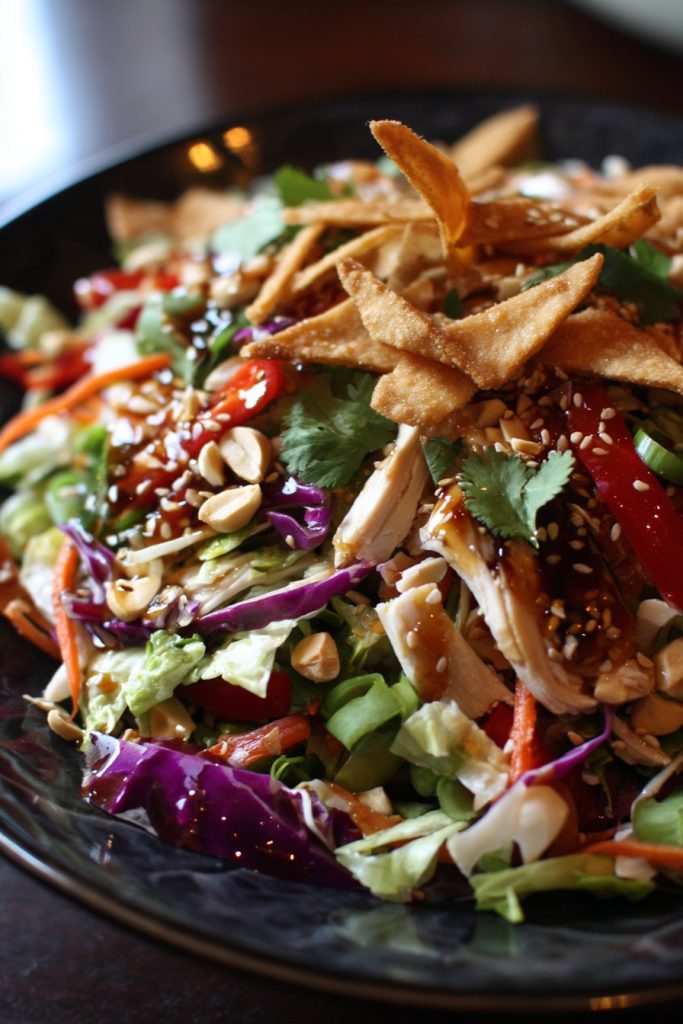Deliciously crunchy, perfectly zesty, and utterly addictive—this Chinese Chicken Salad is about to become your new favorite lunch or light dinner! During my recent trip to San Francisco’s Chinatown, I stumbled upon a little hole-in-the-wall spot that served the most incredible version of this classic, and I knew I had to recreate it at home. After countless taste tests (tough job, I know!), I’ve perfected a recipe that balances sweet, salty, and tangy flavors with an irresistible crunch.
Why This Recipe Works
- The combination of shredded cabbage, carrots, and crispy wonton strips provides a satisfying texture contrast that makes every bite exciting.
- A homemade dressing featuring soy sauce, sesame oil, rice vinegar, and a touch of honey creates a harmonious blend of umami, sweetness, and acidity that coats every ingredient perfectly.
- Using poached chicken breast ensures tender, juicy protein that absorbs the dressing beautifully without becoming dry or stringy.
- Toasted sesame seeds and sliced almonds add nutty depth and extra crunch, elevating the salad from simple to spectacular.
- This recipe comes together in under 30 minutes, making it ideal for busy weeknights or last-minute potluck contributions.
Ingredients
- 1 lb boneless, skinless chicken breasts
- 4 cups shredded napa cabbage
- 2 cups shredded red cabbage
- 1 cup shredded carrots
- 1/2 cup sliced green onions
- 1/4 cup chopped fresh cilantro
- 1/2 cup sliced almonds, toasted
- 2 tbsp toasted sesame seeds
- 1 cup crispy wonton strips
- 1/4 cup low-sodium soy sauce
- 3 tbsp rice vinegar
- 2 tbsp honey
- 1 tbsp sesame oil
- 1 tsp grated fresh ginger
- 1 clove garlic, minced
- 1/4 cup vegetable oil
- 1 tsp sriracha (optional)
Equipment Needed
- Large mixing bowl
- Medium saucepan
- Whisk
- Chef’s knife
- Cutting board
- Measuring cups and spoons
- Salad tongs
- Small bowl for dressing
Instructions

Poach the Chicken to Perfection
Place the chicken breasts in a medium saucepan and cover with cold water by about an inch. Bring to a gentle simmer over medium heat—you’ll know it’s ready when small bubbles form around the edges but it’s not boiling vigorously. Maintain this gentle simmer for 15-18 minutes, until the chicken reaches an internal temperature of 165°F when tested with an instant-read thermometer. Remove from heat and let the chicken cool in the cooking liquid for 10 minutes—this keeps it incredibly moist. Once cool enough to handle, shred the chicken using two forks or your hands, creating nice, bite-sized pieces. Pro tip: Save the poaching liquid! It makes amazing chicken stock for soups later in the week.
Prepare the Crunchy Vegetable Base
In your largest mixing bowl, combine the shredded napa cabbage, red cabbage, and carrots. Napa cabbage provides a delicate crunch while red cabbage adds beautiful color and slightly heartier texture. If you’re short on time, many grocery stores now sell pre-shredded coleslaw mixes that work perfectly here. Add the sliced green onions (both white and green parts for maximum flavor) and chopped fresh cilantro. The cilantro adds a bright, herbal note that cuts through the richness of the dressing. Toss everything together with your hands or salad tongs to distribute the colors and textures evenly. This is also the perfect time to toast your almonds if you haven’t already—just spread them on a baking sheet and toast at 350°F for 5-7 minutes until fragrant.
Whisk Up the Magic Dressing
In a small bowl, combine the soy sauce, rice vinegar, honey, sesame oil, grated ginger, and minced garlic. Whisk vigorously until the honey is completely dissolved and the ingredients are emulsified—you’ll notice the mixture becoming slightly thicker and uniform in color. Taste and adjust seasoning as needed; if you like a bit of heat, add the sriracha now. Slowly drizzle in the vegetable oil while continuing to whisk constantly—this gradual incorporation helps create a stable emulsion that won’t separate. The dressing should coat the back of a spoon nicely. Let it sit for at least 5 minutes to allow the flavors to meld together. The ginger and garlic will mellow slightly while still providing that characteristic zing.
Combine and Toss With Care
Add the shredded chicken to the vegetable mixture in the large bowl. Pour about three-quarters of the dressing over everything—it’s better to start with less and add more as needed rather than overdress the salad. Using salad tongs, toss gently but thoroughly to ensure every component gets coated in that delicious dressing. Lift and fold rather than stirring aggressively to maintain the texture of the delicate cabbage. Now add most of the toasted almonds, sesame seeds, and wonton strips, reserving some for garnish. Toss once more just to distribute these crunchy elements throughout. The wonton strips will start to soften slightly upon contact with the dressing, developing a wonderful texture that’s both crispy and slightly chewy.
Let the Flavors Mingle
This might be the hardest step—waiting! Let the salad sit at room temperature for 10-15 minutes before serving. This resting period allows the flavors to develop and meld together beautifully. The cabbage will wilt slightly, making it easier to eat, and the chicken will absorb more of the dressing. During this time, the textures will transform—the wonton strips become perfectly tender-crisp rather than rock-hard, and the vegetables release just enough moisture to create a cohesive dish. Garnish with the remaining almonds, sesame seeds, and wonton strips for visual appeal and extra crunch. Serve immediately for the best texture experience.
Tips and Tricks
If you want to make this salad ahead of time, here’s how to do it right: Prepare the dressing up to 3 days in advance and store it in an airtight container in the refrigerator—the flavors actually improve over time. You can also poach and shred the chicken up to 2 days ahead; store it in its cooking liquid in the fridge to maintain moisture. The vegetables can be pre-shredded and stored in separate containers with a damp paper towel to prevent wilting. However, never combine everything until just before serving—the dressing will make the cabbage soggy and the wonton strips unpleasantly mushy. For the crispiest wonton strips, you can make your own by cutting wonton wrappers into thin strips and frying them in 350°F oil for about 30 seconds until golden brown, then draining on paper towels. If you’re watching your sodium intake, use reduced-sodium soy sauce and taste before adding any extra salt—the dressing is flavorful enough that you might not need it. For extra protein, add edamame or crispy tofu. If you can’t find napa cabbage, regular green cabbage works fine but will have a tougher texture—massage it with a pinch of salt first to tenderize it. To make this gluten-free, use tamari instead of soy sauce and ensure your wonton strips are gluten-free or substitute with crispy rice noodles. For a nut-free version, omit the almonds and use sunflower seeds instead. The dressing can be customized endlessly—try adding orange juice for citrus notes, peanut butter for creaminess, or chili garlic paste for extra heat. Always taste and adjust as you go—cooking is about personal preference!
Recipe Variations
- Spicy Sesame Version: Add 2 tablespoons of gochujang (Korean chili paste) to the dressing and garnish with extra chili flakes. Include thinly sliced red bell peppers for sweetness and color. This variation brings heat that builds gradually rather than overwhelming the palate, creating a more complex flavor profile that spice lovers will adore.
- Thai-Inspired Twist: Replace the soy sauce with fish sauce, add 2 tablespoons of lime juice, and include 1/4 cup of chopped fresh mint and basil. Top with crushed peanuts instead of almonds. The herbal notes from the mint and basil complement the fish sauce’s umami depth, transporting your taste buds to Bangkok.
- Vegetarian Delight: Omit the chicken and add 2 cups of roasted sweet potatoes cubes and 1 cup of chickpeas. Use a vegetarian oyster sauce or mushroom sauce instead of soy sauce. The sweet potatoes provide natural sweetness that balances the dressing’s tanginess, while chickpeas add protein and substance.
- Low-Carb Option: Replace the wonton strips with roasted seaweed strips or pork rinds, and use sugar-free honey substitute. Increase the cabbage ratio and add sliced radishes for extra crunch. This maintains all the texture excitement while cutting down significantly on carbohydrates.
- Fruity Summer Edition: Add 1 cup of mandarin orange segments and 1/2 cup of dried cranberries. Use orange juice in place of some rice vinegar in the dressing. The citrus brightness and chewy sweetness create a refreshing twist perfect for picnics and warm weather gatherings.
Frequently Asked Questions
Can I use rotisserie chicken instead of poaching my own?
Absolutely! Rotisserie chicken works wonderfully and saves time—just shred about 2 cups of meat from a store-bought rotisserie chicken. The already-seasoned skin adds extra flavor, though you might want to reduce the soy sauce slightly in the dressing to account for saltiness. Remove the skin if you prefer leaner protein, but I recommend keeping it for maximum flavor. This shortcut makes the salad come together in about 15 minutes, perfect for those busy weeknights when you need dinner fast.
How long does Chinese chicken salad keep in the refrigerator?
The undressed salad components will keep separately for 2-3 days, but once dressed, it’s best consumed within 24 hours. The cabbage releases water over time, making the salad soggy, and the wonton strips lose their crunch. If you have leftovers, store them in an airtight container with a paper towel on top to absorb excess moisture. The texture won’t be as perfect but will still taste delicious—some people actually prefer the softer texture the next day!
Can I make this recipe vegan?
Definitely! Replace the chicken with baked tofu or tempeh cubes—marinate them in some of the dressing before baking for extra flavor. Use maple syrup instead of honey (which isn’t vegan) and ensure your wonton strips are egg-free. You could also add edamame, chickpeas, or roasted mushrooms for substance. The dressing already gets its umami from soy sauce, so it adapts beautifully to plant-based versions. I’ve served this to mixed diet groups with great success!
What can I substitute for wonton strips if I can’t find them?
No worries—there are several great alternatives! Crushed ramen noodles (uncooked) provide similar crunch, as do chow mein noodles. For a healthier option, try baked tortilla strips or even roasted chickpeas. In a pinch, you can use store-bought fried onions or even potato sticks. The key is something crispy and neutral that won’t overpower the other flavors. If you’re avoiding fried foods, toasted sunflower seeds or pumpkin seeds add crunch without the oil.
Is there a way to make the dressing less sweet?
Certainly! Reduce the honey to 1 tablespoon or omit it entirely—the carrots provide natural sweetness anyway. You could also increase the rice vinegar by another tablespoon to balance the flavors. Taste as you go and remember that the sweetness will mellow once combined with the other ingredients. Some people prefer adding the sweetness through mandarin oranges or apples in the salad itself rather than in the dressing.
Summary
This Chinese Chicken Salad delivers perfect crunch, bright flavors, and satisfying protein in every bite. With make-ahead options and endless variations, it’s sure to become your go-to recipe for potlucks, lunches, or light dinners. The homemade dressing takes it from good to extraordinary!
Chinese Chicken Salad
6
servings20
minutes18
minutesIngredients
Instructions
- 1 Poach chicken in simmering water for 15-18 minutes until 165°F internal temperature. Shred when cool.
- 2 Combine cabbages, carrots, green onions, and cilantro in large bowl.
- 3 Whisk together soy sauce, vinegar, honey, sesame oil, ginger, garlic, and vegetable oil for dressing.
- 4 Add chicken to vegetables, pour dressing, and toss gently.
- 5 Add most almonds, sesame seeds, and wonton strips, toss lightly.
- 6 Let rest 10 minutes before serving, garnished with remaining toppings.



